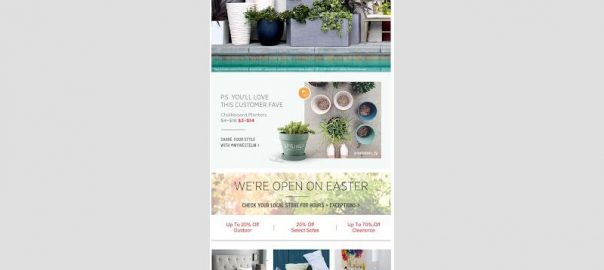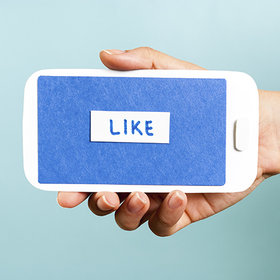— June 10, 2019
Email marketing is one of the most effective ways to grow your business. In fact, email averages a 122 percent return on every dollar invested — and it’s one of the most affordable weapons in your marketing arsenal. Successful marketers know it takes careful planning to stand out in a sea of spam and convert customers. Here’s how to develop an email marketing strategy that works.
What is an email marketing strategy?
Your email marketing strategy is a defined process you’ll follow to leverage email for business growth. Its steps include:
- How you’ll earn email subscribers
- How subscribers will be segmented
- The types of emails you’ll send
- How you’ll weave emails into campaigns
- How you will produce email content
- How you’ll measure responses as well as test and analyze results
- Which software you’ll use to manage your email lists and campaigns
Your email marketing strategy details every aspect of the process, so you can develop a winning system that reliably attracts subscribers and converts them into customers.
How to develop an email marketing strategy
We’ll walk through each step of the process to develop an email marketing strategy that works for your business.
1. Earn email subscribers
Determine how you will convince your audience to subscribe to your email list. Ideas include:
- Sign-up forms on your website (headers, footers, sidebars and pop-ups)
- Gated content (you offer an informative white paper, tool, coupon or other incentive in return for an email address)
- Social media links and forms
- Contests and sweepstakes (both online and off)
- Existing customers (add customers to your email list when they make a purchase, online or off)
- Loyalty/rewards card members
2. Segment subscribers
You also need to consider segmenting subscribers into different lists. This makes it easy to send highly targeted emails relevant to specific customers, which in turn yields better response rates.
For example, you might send one email to existing customers and another to subscribers who have not yet bought from you. That way you can promote complementary products to existing customers and continue to market your primary products to your other subscribers.
ACTION STEP: Make a list of different ways you can attract subscribers. What benefit can you offer in return for their email addresses? What will motivate your target audience to subscribe and trust you? Then, make a list of different subscriber segments you might have. To segment your list, consider where customers are in the buying cycle as well as different customer interests.
3. Types of emails
There are many different types of emails, and it’s a good idea to send multiple types for well-rounded branding that lends a sense of community to your communications. This will also help you identify which types of emails work best with different customer segments.
Types of emails you can send include:
- Promotional emails. These emails market a product or service, seasonal sales, up-sells, cross-sells, discount coupons and other advertising initiatives
- Newsletters. Not every email should be promotional. If you truly want to engage subscribers, send regular newsletters that offer useful information, helpful tips and tricks, how-to guides and problem-solving solutions
- Thank-you emails, order confirmations and receipts. These are sent after customers make a purchase. They typically recap what was purchased, the final price and delivery information. Don’t miss this opportunity to deliver an attractive offer — customers who have just bought from you are likely to buy again
- Shipping updates. These are sent out with tracking information for shipped packages. You can also use them to deliver a special offer to recent customers
- Abandoned cart emails. Send these to people who have added items to their shopping carts but have not yet purchased. Deliver a discount coupon or other incentive that nudges them to complete their purchases
- Event announcements and confirmations. If you host events such as webinars, seminars, trade shows or conferences, email is a fantastic way to boost attendance. You can also use email to promote your podcasts, videos, blogs and social media channels
- Interactive emails. Send emails that link to interesting infographics and videos to maintain interest in your brand. Another idea: send surveys with a chance to win a prize. Surveys can help you glean valuable insight into your customers’ wants, needs and purchasing behavior
- Referral emails. Offer subscribers an incentive to refer your business. For example, they might get a freebie or gift card for every new customer they refer
- Contact form and support ticket responses. Automated emails let customers know you have received their requests. Add a promo in the footer or sidebar, especially once you’ve successfully resolved issues or otherwise helped your prospects and customers
- Account and subscription confirmations. Once subscribers have opted in, follow up with a “welcome to the team” email that delivers an attractive incentive to buy
- Unsubscribe confirmations. No matter how great your emails are, some people will unsubscribe. Respect their decision, but be sure to follow up with an unsubscribe confirmation that invites them to subscribe again any time, subscribe to a different or more relevant list, adjust the frequency of emails or take advantage of a “going away” gift
ACTION STEP: Make a list of all the types of emails you’ll send. Jot down a goal or desired outcome for each type of email. Then, brainstorm ways to craft emails that influence those outcomes, such as strategically placed calls to action.
In this promotional email from MeUndies, the company promotes its T-shirt benefits and ties them in with its brand image.
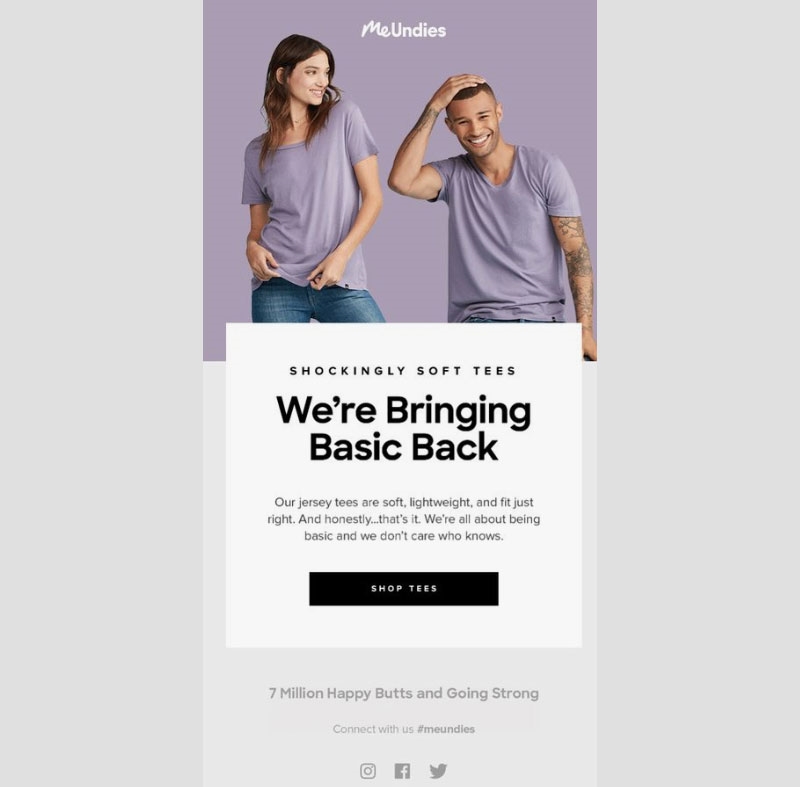
4. Weaving emails into campaigns
Some emails are triggered by one-time events. For example, order confirmation emails. Other emails are part of a series intended to motivate a specific response. For example, you might attract subscribers with an eBook. When a subscriber opts in, it triggers a series of emails delivered at a predefined frequency.
Known as drip campaigns, these emails are created in advance and nurture leads through the buying cycle until they ultimately make a purchase. Drip campaigns are easy to set up with email autoresponder tools and offer advanced marketing automation that forks subscribers’ paths depending on their behavior.
For example, let’s say you sell fitness equipment. You attract subscribers by offering a free workout plan eBook. These leads are entered into a sales funnel: Your email automation software sends regular emails that feature fitness news, events, new workout ideas and products.
Now, let’s say one of your emails includes a link to a new yoga mat you sell. People who click to learn more can automatically be sent emails that focus on the benefits of yoga mats, and specifically, what makes your yoga mat so great. Instead of getting your general email, they can now receive an email that says you noticed they were interested in your yoga mat and offer them a discount if they buy it now.
By using marketing automation to segment subscribers in this manner, you’re able to send personalized and relevant email campaigns that yield the best conversion rates. Not only that, you can keep customers coming back and even foster long-term relationships that lead to advocacy and ambassadorship.
ACTION STEP: Map out an email campaign funnel from start to finish. Begin with how you will attract subscribers, the types of emails you’ll send and how frequently you will send them. If you’re going to employ marketing automation, include forks to different email paths (buyer journeys) based on triggers (subscriber behavior).
This promotional email from LuLu’s Fashion Lounge promotes a summer sale and adds a sense of urgency with its call to action.
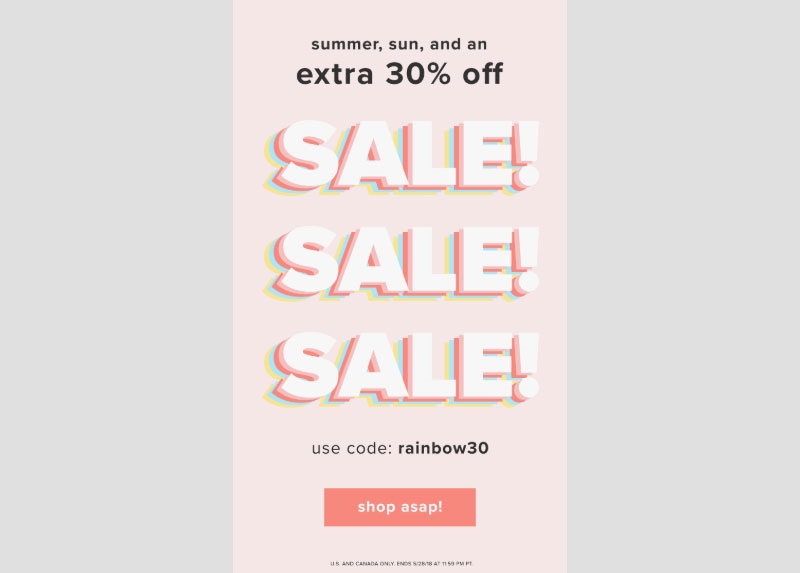
5. How to produce email content
Email production will be a core component of your overall email marketing strategy. Determine your production process, so you can maintain consistency that drives results.
Consider the tone of your emails: Will you be an authority voice, a friendly adviser, a humorous columnist or a boisterous carnival barker? Your voice is part of your branding and should persist throughout your emails.
You also need to consider email design. Develop a style guide for email fonts, headlines, images and colors. It’s a good idea to create an email template for each type of email you send. That way it will be easy to deploy new emails quickly.
Decide who will create your email content. You can write and design emails yourself, have your in-house staff do it or hire an agency or freelancer to create it. No matter how you create your emails, give yourself plenty of lead time so you can plan campaigns in advance. That will give you ample time to make revisions and take advantage of last-minute email marketing opportunities.
ACTION STEP: Identify the tone, or voice, your emails will adopt. Create a style guide and email design templates. Then, identify who will produce your emails and develop a production process and timeline.
This welcome email from Handy offers helpful information about how to get the most from its service: It promotes an app download, tells customers how to edit their bookings and promotes cross-sells to additional services.
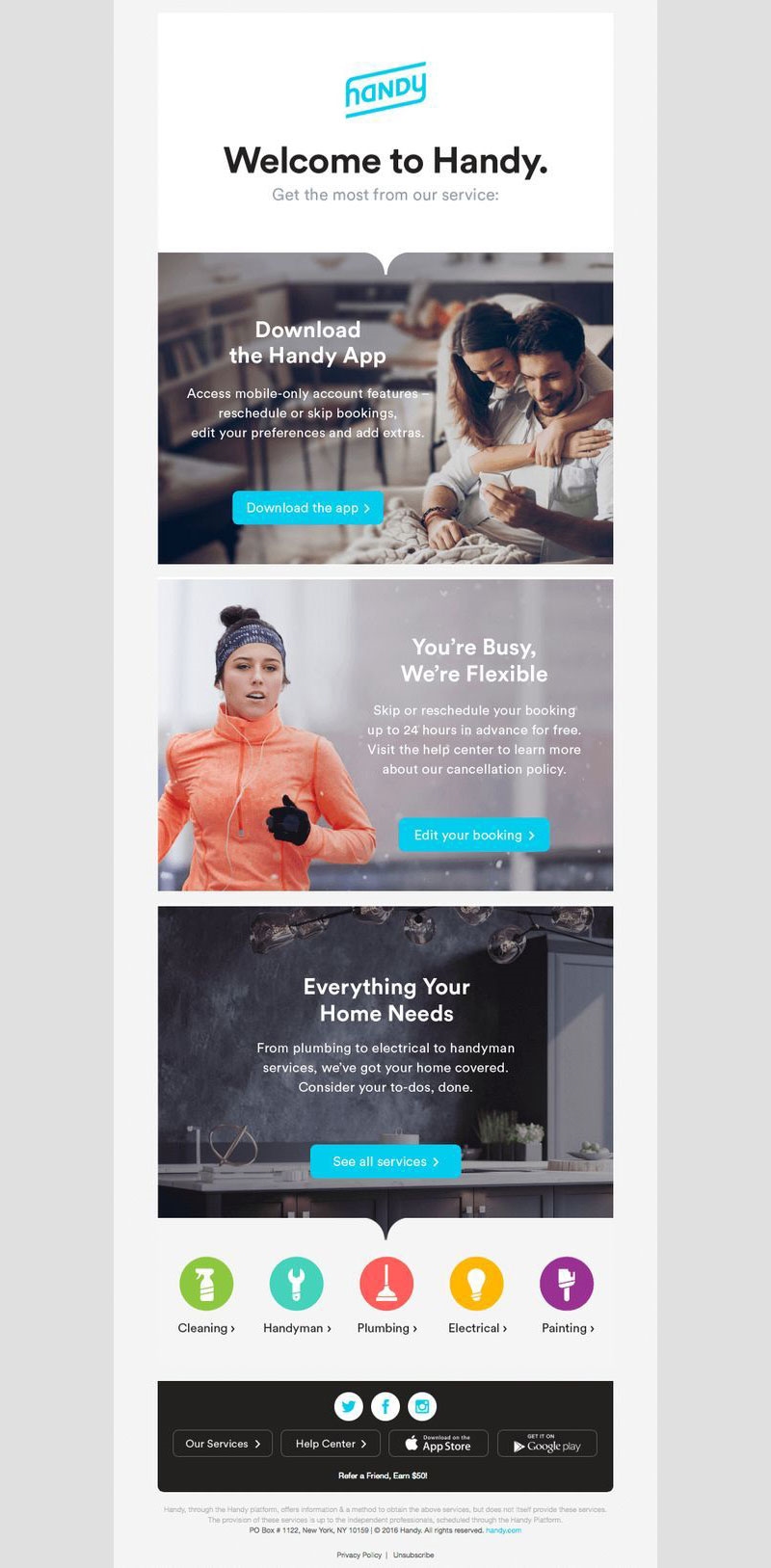
6. Measure email responses and analyze results
Track email opens and clicks to determine how effective your emails are. Use software, like VerticalResponse, to create A/B tests to identify which version of a given email achieves the best results. For example, you can test two subject lines against one another to see which gets more opens. Analyze the results and apply what you learn; over time, you can optimize emails for predictable success.
You can also track which devices subscribers use, identify which geographic areas yield the best response rates and view heat maps that show where customers click in your emails. This information will help you develop stronger emails that deliver results.
ACTION STEP: List everything you want to track in your emails: opens, clicks, geography, subscriber devices and heat maps.
7. Choose email marketing software
Email marketing is a powerful strategy, but manually managing subscribers, email lists and segments is tedious, time-consuming and error prone. Manual management makes email automation impossible and tracking difficult. That’s why it’s best to use an email marketing tool that simplifies the entire process.
For example, VerticalResponse makes it easy to create subscribe forms, add gated content, build email templates, manage and segment subscriber lists and automate marketing with autoresponder triggers. It also offers a full suite of email tracking and analysis tools, including the ability to compare metrics between multiple email lists.
ACTION STEP: Choose email marketing software that enables you to execute your email marketing strategy efficiently.
Examples
You know how to develop an email marketing strategy. Now, let’s examine a few examples of email marketing in practice.
Ecommerce examples
Example 1: Patio furniture
A patio furniture company wants to sell table and chair sets to its audience. The company knows its target audience likes to entertain guests, so it develops a guide to hosting the perfect patio party. It markets the guide to people who meet its audience demographics via Facebook advertising.
Subscribers receive two emails per week: The first is a newsletter packed with outdoor entertaining and décor tips. It links to expanded articles on the company’s website. The second email is promotional: invitations to review its online catalog, plus special discounts on featured table and chair sets.
Some subscribers buy table and chair sets and are automatically placed in a new segmented list: table and chair buyers. They continue to receive the weekly newsletters, but the promotional emails they receive are centered around complementary products, including fire pits, outdoor swings, serving trays and décor.
Non-buyers stay in the first list until they buy or the company decides they’re not going to purchase table and chair sets and begins serving them different offers.
This email from West Elm showcases top products to create desire, then sweetens the deal with a discount coupon.
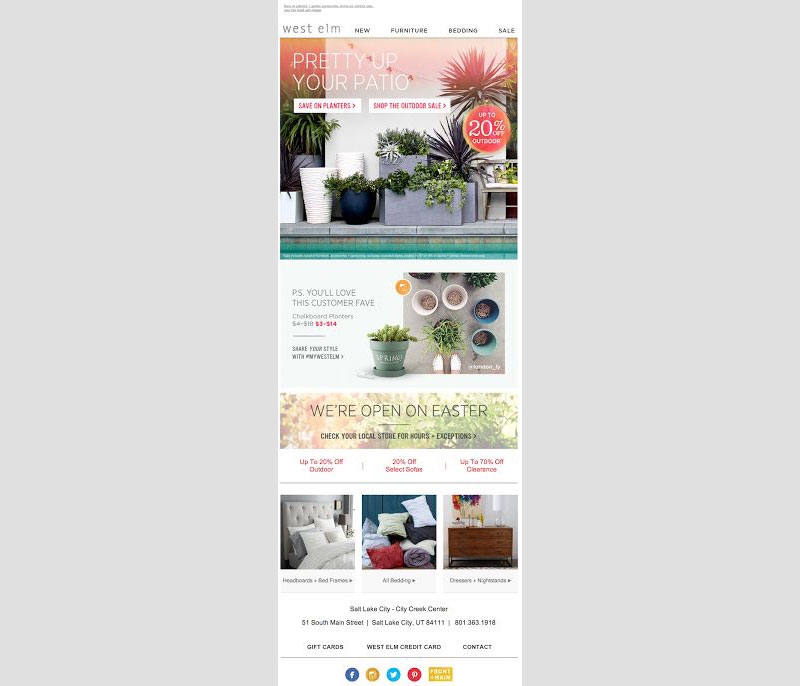
Example 2: Athletic apparel
A company that sells athletic apparel wants to make a big fall push for its basketball shoes. It creates a video course to help players improve their games. They must subscribe to gain access to the course. The company already gets a lot of traffic to its blog, so that’s where it promotes the course.
The company delivers a new instructional video via email every other day over the course of three weeks. Each email also contains a promotion for a popular basketball shoe and links to a product detail page. A time-limited coupon code is added to motivate purchases.
Buyers and those who have completed the course are moved to a new segment that receives regular newsletters, plus promotions for other basketball-related products. One of the emails includes a survey that asks which sports they play: basketball, baseball, football, soccer, etc. Subscribers are then segmented into new lists according to their preferred sports.
This email from Nike leads with the primary benefits of its Dri-FIT apparel and illustrates how it aids in running and training to add relevance to its audience.
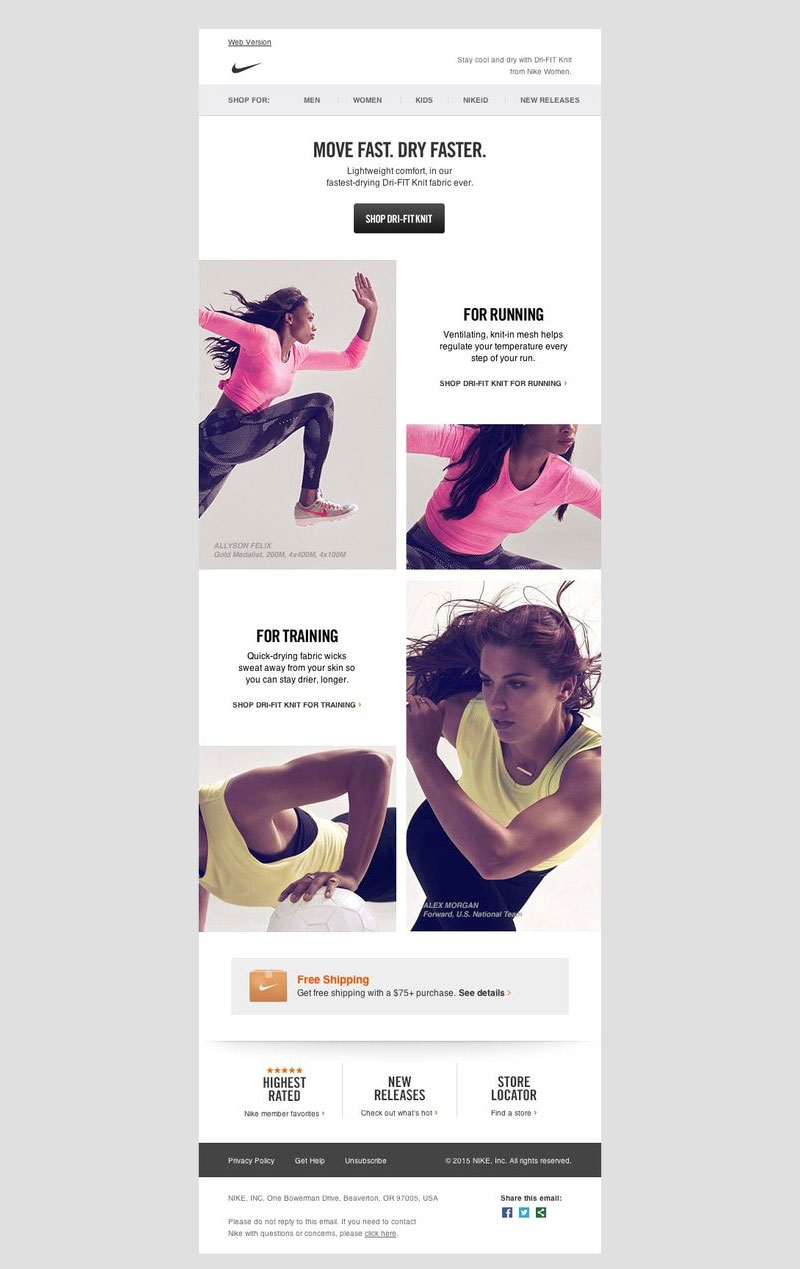
Example 3: Landscaping company
A local landscaping company wants to earn new clients. The company creates an eBook packed with lawn beautification tips. It promotes the eBook on its Facebook page, which has a large local following, to attract subscribers.
The company sends regular newsletters that feature more outdoor improvement tips, before-and-after photos, plus customer testimonials to promote its landscaping services. Each newsletter features a time-limited offer.
Buyers are segmented into a referral list that encourages them to refer their friends and family members. The landscaping customer offers an annual freshen up to the referring customers plus a discount to the referred customers to sweeten the deal.
B2B examples
Example 1: Accounting firm
An accounting firm wants to earn new clients. The company creates a sweepstakes in which the winner gets free tax preparation. It markets the deal on its website, social media and through partnerships with business bloggers. To enter, companies must submit their email addresses.
The company sends subscribers tips such as which business expenses are tax-deductible and how to track mileage. The newsletters are valuable and likely to be read by subscribers, and so they work by reinforcing the idea that the accounting firm is a trusted expert that can help them.
Their branding efforts pay off: When customers need them, the accounting firm is top-of-mind and gets the call.
Example 2: Office supply company
An office supply company wants to increase its weekly delivery client base. It creates a case study that details how it saves companies an average of 25 percent on its office expenses. The company promotes the case study to office managers via LinkedIn ads and articles, Facebook and on its own website. Office managers must subscribe to a newsletter to access the case study.
The newsletter builds upon the original case study with money-saving tips for office managers. Each week, a second email is sent with discounts on top office supplies.
Customers are segmented according to what they buy. For example, those that buy a large volume of copier paper are sent promotions for paper and complementary products such as toner.
Conclusion
In these examples, you can see how your business can leverage the power of email marketing to boost brand recognition, deliver relevant messages to targeted customers and ultimately yield high conversion rates. Email is one of the most affordable marketing channels, which makes it a perfect platform for every business no matter its budget. It’s easy, too, when you use automated email marketing software. Follow the tips in this guide to develop a profitable email marketing strategy that grows your business fast.
Digital & Social Articles on Business 2 Community
(89)
